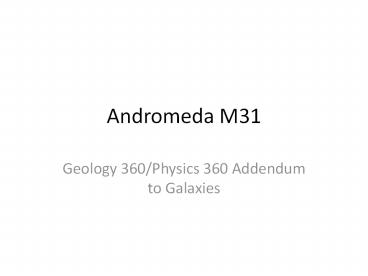Andromeda M31 - PowerPoint PPT Presentation
1 / 9
Title:
Andromeda M31
Description:
Andromeda M31 Geology 360/Physics ... That means that every star returns to the same position in the sky at that same interval ... and blue-white Rigel below it ... – PowerPoint PPT presentation
Number of Views:101
Avg rating:3.0/5.0
Title: Andromeda M31
1
Andromeda M31
- Geology 360/Physics 360 Addendum to Galaxies
2
(No Transcript)
3
(No Transcript)
4
(No Transcript)
5
(No Transcript)
6
Andromeda Galaxy (Hubble Telescope) 2.5 million
LY away
7
The Future Fate of the Milky Way Galaxy -
Collision Scenario for the Milky Way and
Andromeda Galaxies The Milky Way and the
Andromeda galaxy are approaching each other with
a speed of 300,000 miles per hour. It's not
certain yet whether we're in store for a head-on
collision or a simple sideswiping by the massive
galaxy, which is a near twin to the Milky Way.
Astronomers will first need to use powerful new
telescopes to precisely measure Andromeda's
tangential motion across the sky. (Just as a
baseball outfielder estimates whether a ball is
heading directly toward him or is going to miss
him by determining whether the ball is moving
sideways.) A direct collision would lead to a
grand merger between the two behemoths, and the
Milky Way would no longer be the pinwheel spiral
we are familiar with, but would evolve into a
huge elliptical galaxy. It would happen no sooner
than five billion years in the future. By then
the Sun may have burned out, and the Earth
reduced to a frigid, lifeless cinder. It's
impossible to predict if there would be any
vestige of humanity colonized among the stars,
not to mention extraterrestrial civilizations
around to witness this great collision. The
collision will take several billion years to
fully run its course, so it will be hard for any
one civilization, like ours, to fully understand
the vast scale - both in time and space of the
collision.
8
Measuring the distance to galaxies Cephid
Variables (are a million solar luminosities) Iden
tify the luminosity of the Cephid Variable by
measuring its period. Knowing the luminosity
using the candlepower equation find the distance
to the cephid variable within the galaxy.
Using V H d is also another way to measure
the distance to galaxies. You have to measure the
recessional velocity of the galaxy. The faster a
galaxy recedes the farther away it is. (H is 70
kilometers per second per megaparsec) To
measure the diameter of a galaxy, we treat it
just as we would measure the diameter of the moon
knowing its distance. D (diameter) 2 Pi A
d/360 where A is the angular size in the sky in
degrees.
9
From Stardate.org April 23 Vanishing
Orion Orion, the hunter, is bowing out of the
evening sky. He's low in the west at nightfall,
and his stars begin dropping from view not long
afterward. The constellation will be pretty much
lost from sight by the middle of May.Like the
hour hands on a giant celestial clock, all the
stars loop from the morning sky to the evening
sky and back again once a year. That motion is
caused by Earth's motion around the Sun.Earth
rotates on its axis once every 23 hours and 56
minutes. That means that every star returns to
the same position in the sky at that same
interval -- except one the Sun.The difference
is our orbit around the Sun. Each day, Earth
moves about 1.6 million miles along its orbital
path. So our planet has to rotate a little longer
for the Sun to return to the same position in the
sky as the day before four minutes.That means
the other stars rise and set four minutes earlier
each day, so they loop around the sky during the
year. Back around Thanksgiving, for example,
Orion was just climbing into view in the east as
night fell. Now, it's on the opposite side of the
sky, just sinking into the sunset. But it'll
return to view in midsummer -- this time in the
morning, as it begins yet another cycle across
the sky.For now, look for Orion low in the west
beginning not long after sunset. His "belt" of
three bright stars runs parallel to the horizon,
with bright orange Betelgeuse above the belt, and
blue-white Rigel below it.































